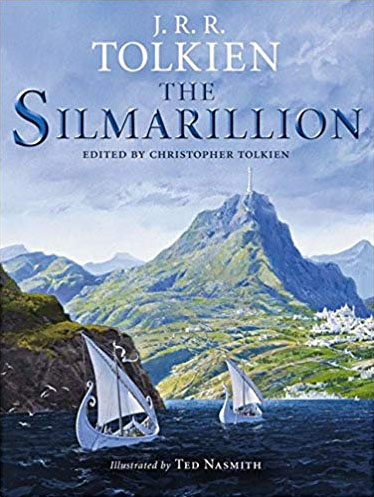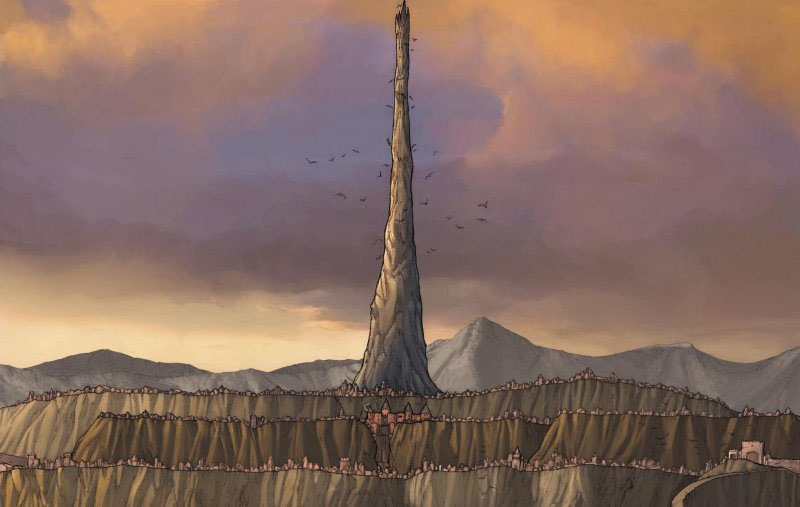The features revealed as their hoods fell back were those of goblins – but goblins possessed of sickly gray skin. More disturbingly, the eyes and mouths of each goblin had been sewn shut with thick, black string. Despite this, all of them moved with sure, fluid motions.
In the Shadow of the Spire is actually the fifth campaign I’ve run in my Western Lands setting. I believe I’ve actually previously discussed that Ptolus first appeared at my gaming table 5+ years earlier when a group passed through the city and noted its distinctive Spire as they passed from the Southern Sea back towards Deepfall Pass in the west.
One of the players in that campaign, Dave, was Agnarr’s creator. Two other players had also previously played in Western Lands campaigns.
One of the cool things I think you can do when running multiple campaigns in the same setting (whether concurrently or over time) is to have crossovers between those campaigns. And also to have deep, long-term mysteries that are intrinsic to the setting and which are only slowly revealed
A good example of this sort of thing, from Monte Cook’s original Ptolus campaign, is the revelation that the entire world of Praemal is actually a planar prison for demons. Everyone else is just stuck there by accident, and the demons are constantly trying to dissolve the bonds of the prison and escape. That’s the kind of thing which can be quietly true for any number of campaigns – with various enigmas suggesting the truth only for the final revelation to really blow people’s minds.
(This particular set of metaphysics, it should be noted, isn’t true of the Western Lands, which is one of the reasons why my version of Ptolus diverges from Monte Cook’s, and does so rather severely in some key areas.)
Of course, this sort of thing doesn’t require tapping into the fundamental metaphysics of the entire campaign world. Sometimes it might be, “Hey, you know Good King George? The guy who’s been the beneficent monarch ruling over the kingdom for the last three campaigns? Turns out he’s actually a mind-controlled puppet and the whole kingdom is being run by the drow. And he has been his entire life.”
It’s also fun to have references to the PCs from the other campaigns and/or the things that they did. Those enduring legacies across years of play can really invest players into the setting, knowing that their actions will resonate not just in the campaign itself, but across campaigns. That perhaps players who they have never even met will be affected by what they’ve done today.
(The most ambitious example of this I’ve ever attempted was when the players in one campaign met the future versions of their PCs from the other campaign. Have I told that story?)
On the other hand, sometimes these crossovers are just, “Hey! Remember that cool character/monster/location from the last campaign?!”
Dave, for example, recognized the name Ritharius from that previous campaign. The revelation of Ritharius’ actions later in the campaign would have carried a little extra oomph because of that, I think. (And when Dave left the campaign I made a point of building Ritharius into Tor’s background to reposition that oomph.)
These creepy goblins are a little bit of both.
They first appeared in one of the earliest scenarios I ever ran for 3rd Edition, a remix of The Sunless Citadel in which the lower levels of the scenario had been transformed into a much more horrific venue. In both cases, the nature of these goblins points towards the much deeper truth that [SPOILERS REDACTED] and also that [SECURITY CLEARANCE REQUIRED]. But mostly they would have just been a cool cameo that players from that campaign would recognize.
Unfortunately, the player who would have recognized the goblins left the campaign before they showed up. C’est la vie.
This does highlight, however, that this technique can be of arguably limited value because there is a limited audience capable of appreciating the full context of these crossovers and callbacks. I would argue, however, that when done properly these things still have value even when no one is necessarily there to directly appreciate them.
 Consider, for example, the success J.R.R. Tolkien had in using the then-unpublished Silmarillion to create mythological depth in The Lord of the Rings. Queen Berúthiel’s cats (a reference in Lord of the Rings which, infamously unlike many of Tolkien’s other “historical” allusions, was created off-the-cuff as he was writing) are also a thing, of course, but there is, I believe, both a qualitative and practical difference between such off-the-cuff improvisations and a fully-integrated body of lore.
Consider, for example, the success J.R.R. Tolkien had in using the then-unpublished Silmarillion to create mythological depth in The Lord of the Rings. Queen Berúthiel’s cats (a reference in Lord of the Rings which, infamously unlike many of Tolkien’s other “historical” allusions, was created off-the-cuff as he was writing) are also a thing, of course, but there is, I believe, both a qualitative and practical difference between such off-the-cuff improvisations and a fully-integrated body of lore.
The problem, of course, is that creating fully-integrated bodies of lore is a time-consuming process. And as cool as it can be a player digs into something and discovers that there is, in fact, a vast ocean of lore to explored there, the odds of wasted prep are quite high. Campaigns you’ve previously run, however, are inherently “fully-integrated bodies of lore”, and thus this can work both ways: Stuff you’re calling back to is “free prep” for the current campaign (you’ve already prepped it). And, on the flip-side, designing material that’s intended to be useful for campaign after campaign after campaign can be very high value prep indeed.
And, honestly, I find these callbacks and crossovers entertaining and rewarding in their own right on a purely personal level, even if no one else at the table is ever aware of it. In that sense, I am like the watchmaker who carefully filigrees the gear of a pocket watch which the owner will never be able to see: There is a pride and a pleasure in seeing the pieces of a job well done slide into place.













Long ago, in the ’70s, I tried to start out with large tapestries of lore. Urgh, never again.
I have certainly profited from criss-crossing campaigns over the same terrain.
Lately I realised that my backgrounds grow as the campaigns move forward and incorporate myths and legends that are contradictory.
In my open table campaign I started with some bare bones back story – elves and orcs were both great civilisations that destroyed themselves in a global war 6,000 years ago. The elves created the dragons from pseudo dragon stock as a weapon in the war but it all went wrong when the majority of the 1st generation became evil and turned on orc and elf alike, so today the world is dotted by chromatic dragons in control of huge territories everywhere.
As play progressed things got added as part of adventures. I added the legend of the lost elvish capital, Risome, that is timelocked by terrible spells. In one adventure an iron throne in a dungeon evolved into The Iron Throne that holds the spirits of ancient orc leaders (now possessing some dwarves and rebuilding their kingdoms). That in turn caused the creation of a collection of dark iron artefacts of orcish origin that players have set out to destroy. I had a Strahd type vampire scenario set up, which morphed into an ancient elvish Queen who became the first vampire after making a deal with a demon to try and defeat the orcs. Her kingdom survives within the reach of her influence but all is not well. Add in two teleport networks that both the orcs and elves operated in their day and there is all sorts of history.
As the players encounter things they keep suggesting what they think they have pieced together. That is a great source of inspiration for filling in even more bits of ancient back story. And then of course the players themselves are creating legends about themselves. Its cool.
I enjoy the personal satisfaction of seeing multiple campaigns interact and the free prep. The long continuity in my setting really builds interest looking forward and back. Something amiss all along (in the same campaign, let alone over multiple) and the truth being revealed still has a solid punch. It also is a great way to supplant core RPG setting material slowly and replace with your own, ex. powerful PCs replace standard setting deities, changes in the setting involve rewrites of racial abilities, etc., without being overwhelmed by campaign prep before it begins.
The character development of NPCs and retired PCs is very fun as well. Long term NPCs always get replay in my games if they were popular with players. A fun example are my two Awakened Bear Death Priests inspired by the Oglaf comic, “Rough Trade”. It is really pleasing to see players react to a previous NPC as a good friend (or laughingstock) they fell out of touch with.
>Tor’s background [LINK]
There is not in fact a link.
Fixed! Thank you!
I love these kinds of crossovers.
In my second campaign in my setting, I had a bandit encounter that went hilariously badly for the flamboyant bandit leader. So much so, that our PCs commissioned a bard to write a comedic ballad lampooning his ineptitude. It was a huge success.
Now, thousands of years later, he is a Falstaff-like archetype in many a comedic opera, in the Comedia del Arte style. His name has gone down the ages in constant ridicule. I even wrote an entire short opera bufo script as a handout about his bumbling schemes. (He ends up marrying a gorilla instead of a wealthy heiress)
Initially, I’d been a little annoyed to have my npc so viciously mocked, but I ran with it and I’m glad I did.